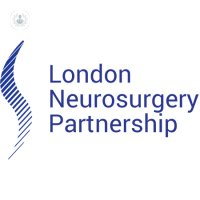Hydrocephalus
Mr Mansoor Foroughi - Neurosurgery
Created on: 11-13-2012
Updated on: 09-20-2023
Edited by: Conor Lynch
What is hydrocephalus?
Hydrocephalus is the name given to the build-up of excess cerebrospinal fluid in the brain (water on the brain). The function of this substance is to protect the brain, but too much of it puts harmful pressure on the brain. Cerebrospinal fluid also surrounds the spinal cord.
This condition can be congenital, which means that you are born with hydrocephalus or it can be acquired, which means that you develop it after birth as a result of other factors including tumours, infections such as meningitis and bleeding on the brain. This is a common condition in babies with myelomeningocele.
The specialist responsible for treating it is a neurosurgeon.

What is the prognosis of the disease?
Hydrocephalus can cause permanent brain damage and problems with physical and mental development. If treated, sufferers can lead a normal life (although with certain limitations) but, if left untreated, it can be fatal.
The best prognosis for hydrocephalus is for hydrocephalus that is not caused by infection.
What are the symptoms of hydrocephalus?
There are a variety of different symptoms that can affect children and adults. Symptoms in children can include:
- irritability and poor head control
- vomiting
- drowsiness
- eyes that seem to turn downward
- the child’s head may enlarge more than the face
And in older children and adults:
- headaches
- balance problems
- blurred vision
- nausea
- problems with thinking and memory
In addition, this pathology in babies causes the soft spot of their head to bulge.
How is it diagnosed?
A CT scan of the head is performed to diagnose hydrocephalus. This may be accompanied by an MRI scan of the brain and spinal cord, skull ultrasound, lumbar puncture, and various X-rays.
What causes hydrocephalus?
Hydrocephalus may be caused by genetic problems or problems in the foetus during pregnancy. Signs of its presence include:
- blockage of cerebrospinal fluid flow
- cerebrospinal fluid cannot be absorbed into the blood
The brain produces too much cerebrospinal fluid. When this happens, this fluid puts pressure on the brain, pushing it upward and damaging the brain tissue.
Can it be prevented?
In babies, the head can be protected from injury and infections and other disorders associated with hydrocephalus can be avoided.
How is hydrocephalus treated?
Treatment for hydrocephalus depends on the cause. It the cause is a brain tumour blocking the flow of cerebrospinal fluid, then removing the tumour may be the best treatment. However, most patients with the condition will require a procedure to divert the cerebrospinal fluid away from the brain. They may undergo surgery to implant a shunt, a flexible but robust tube that diverts fluid flow to another area of the body where it can be absorbed.
In some cases, fluid may be re-routed within the brain with an endoscopic third ventriculostomy. The surgeon makes a hole in the floor of the brain to allow the trapped fluid to move away from the surface of the brain where it can be absorbed. Other complementary measures may include medicines, removal of the parts of the brain that produce cerebrospinal fluid, and rehabilitation.
If my baby acquires hydrocephalus at birth, what will happen?
It is likely that your baby will need to undergo surgical treatment as soon as possible if he or she acquires hydrocephalus from birth. A shunt will, in the majority of cases, be the most appropriate and effective treatment option. Parents should seek urgent medical advice from a paediatric neurosurgeon if their baby has been diagnosed with congenital hydrocephalus.
What are the possible post-surgical complications?
If a shunt is used to divert the blocked fluid to other parts of the body and away from the individual's brain, the shunt could possible become either blocked or infected. Bleeding in the brain, epilepsy, and blurred vision are all other possible side effects of surgical treatment for hydrocephalus.
How will I know if the shunt procedure has caused infection?
There are various symptoms that patients will typically present with that would likely indicate infection as a result of a shunt surgical procedure to treat hydrocephalus. These symptoms include:
- neck stiffness
- high temperature
- vomiting
- irritability or sleepiness in babies











